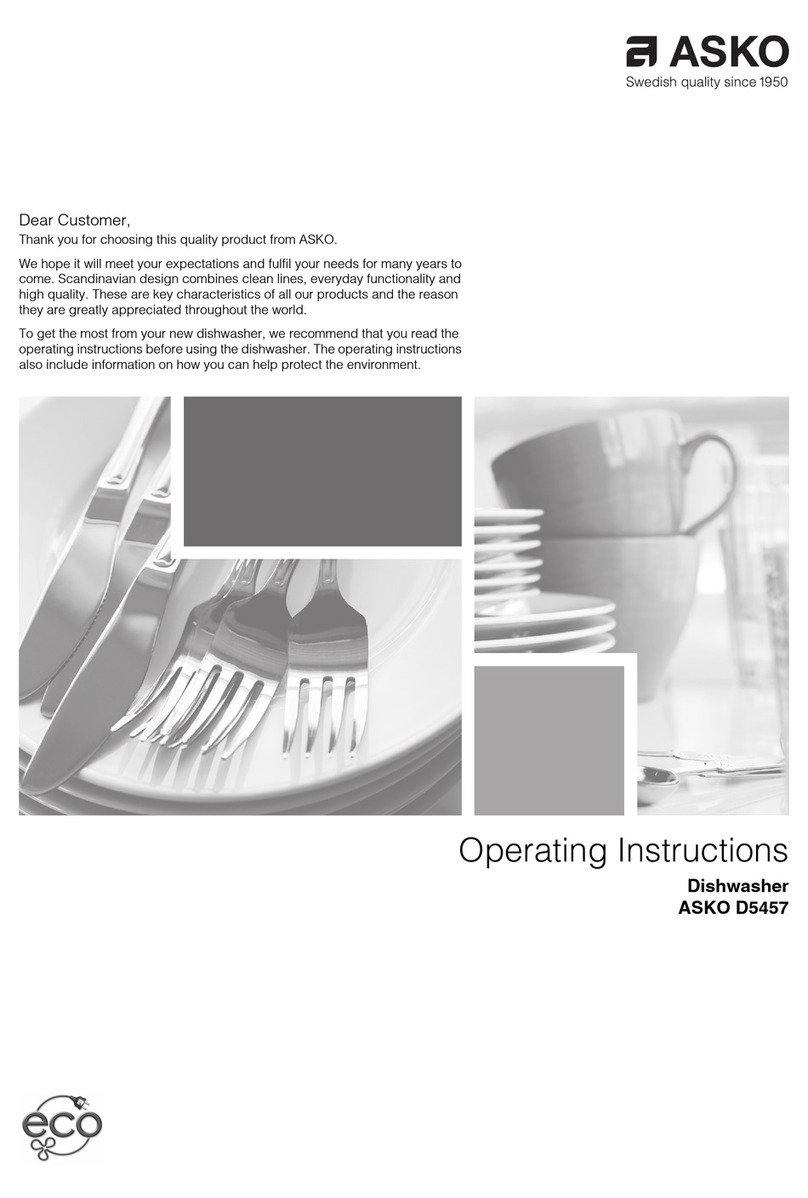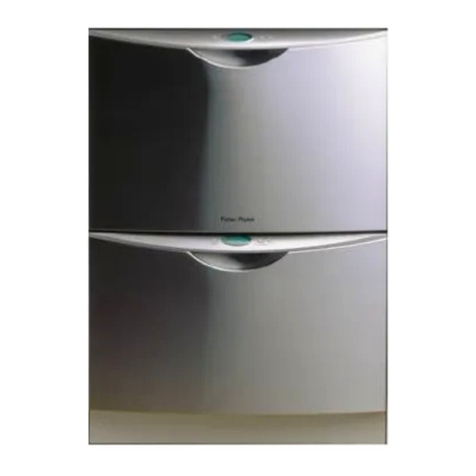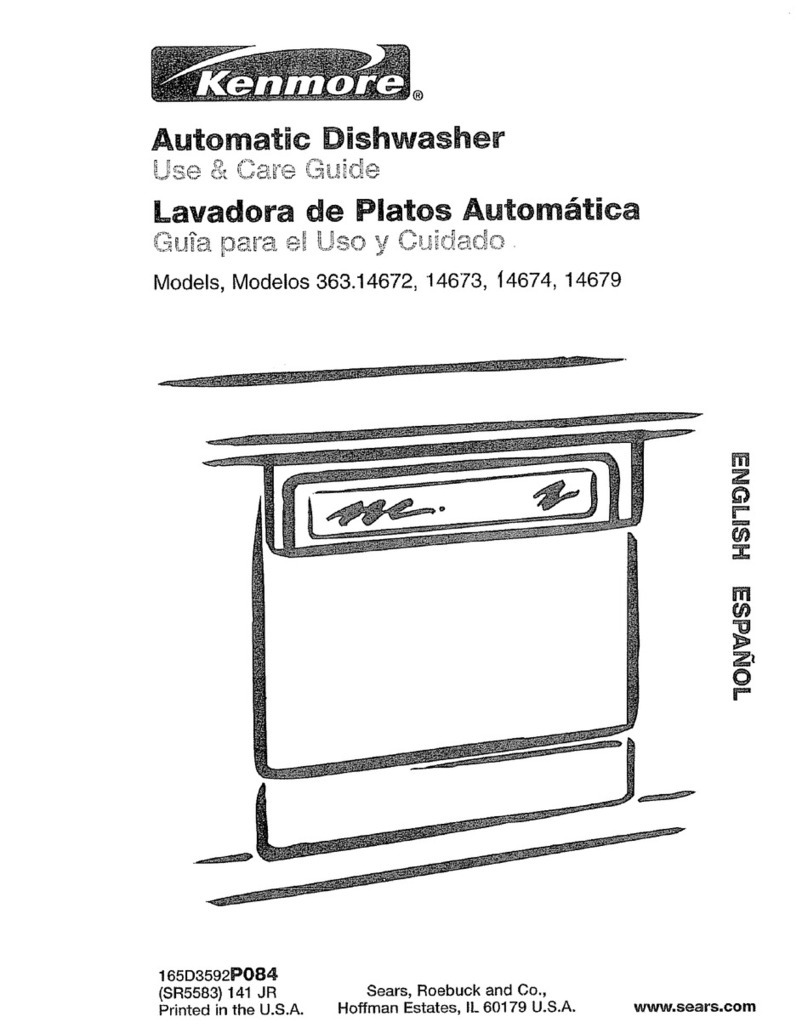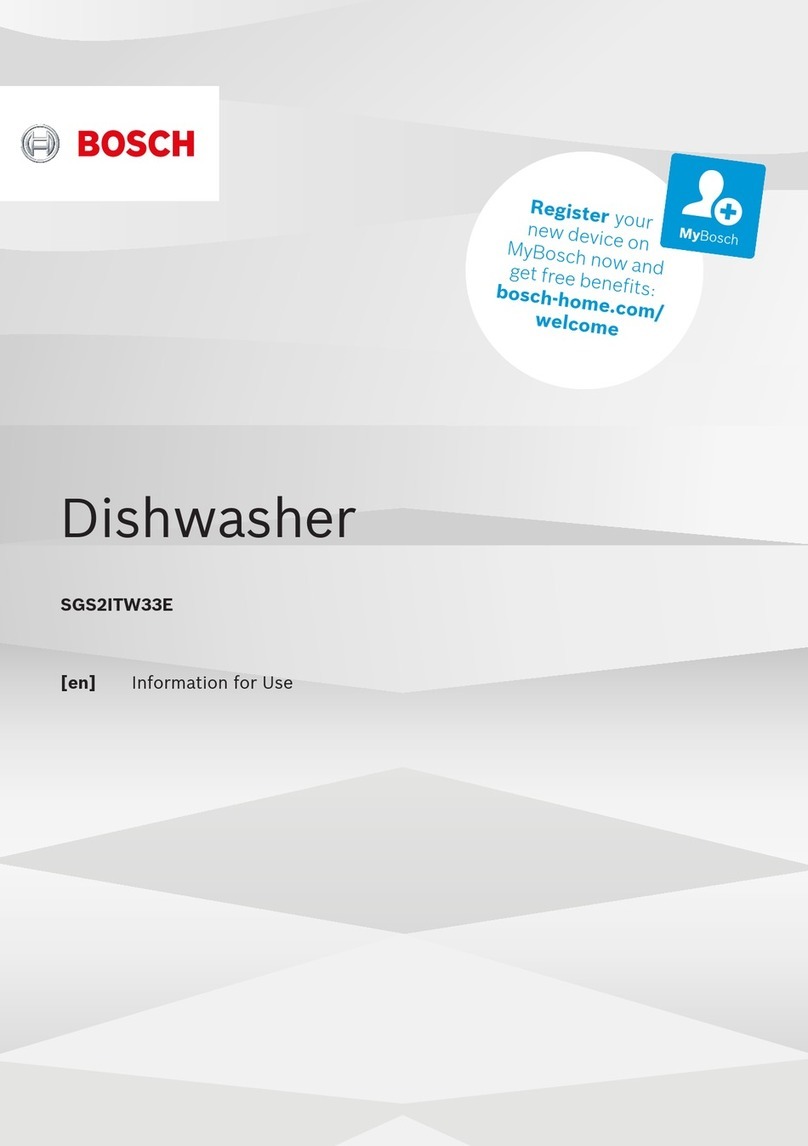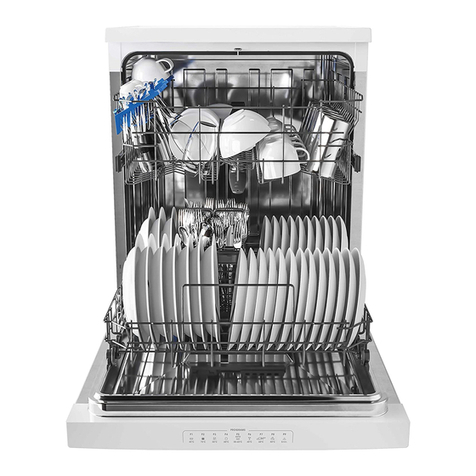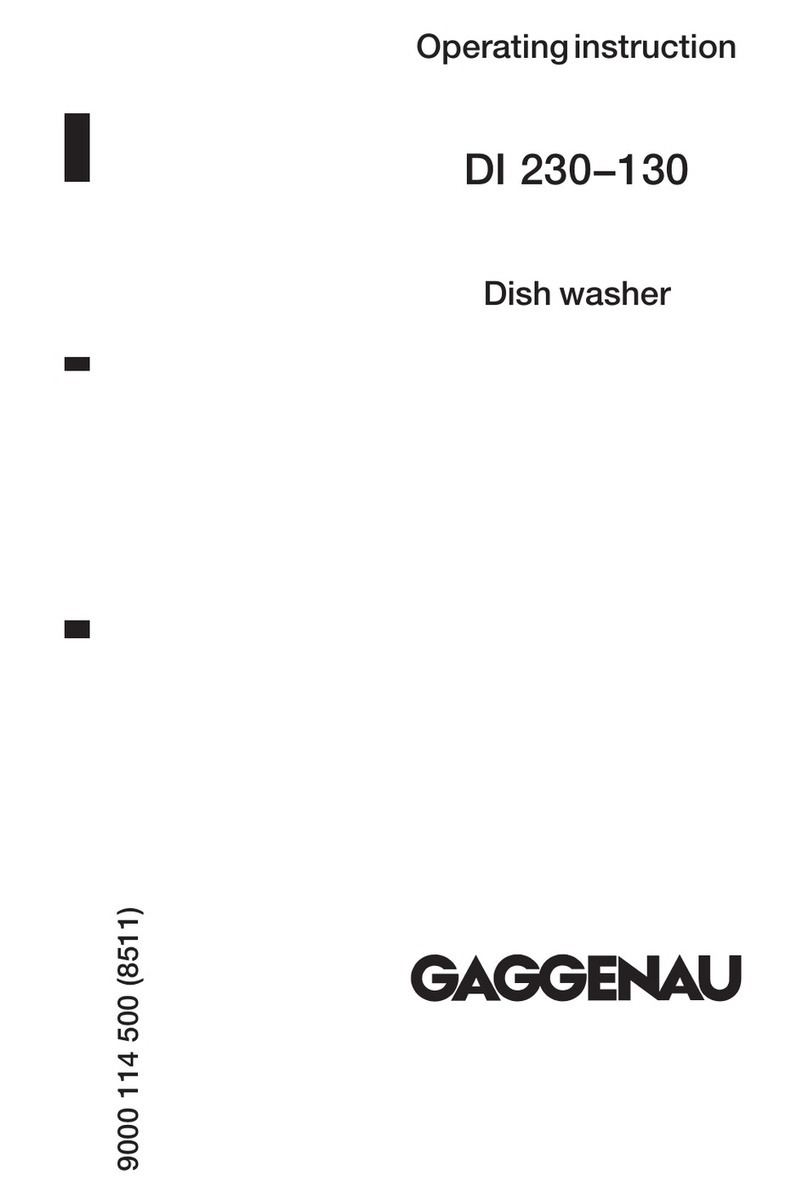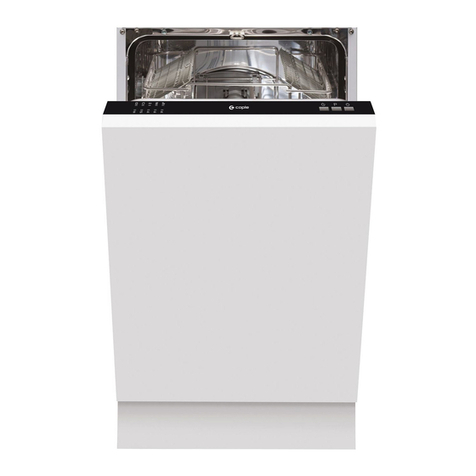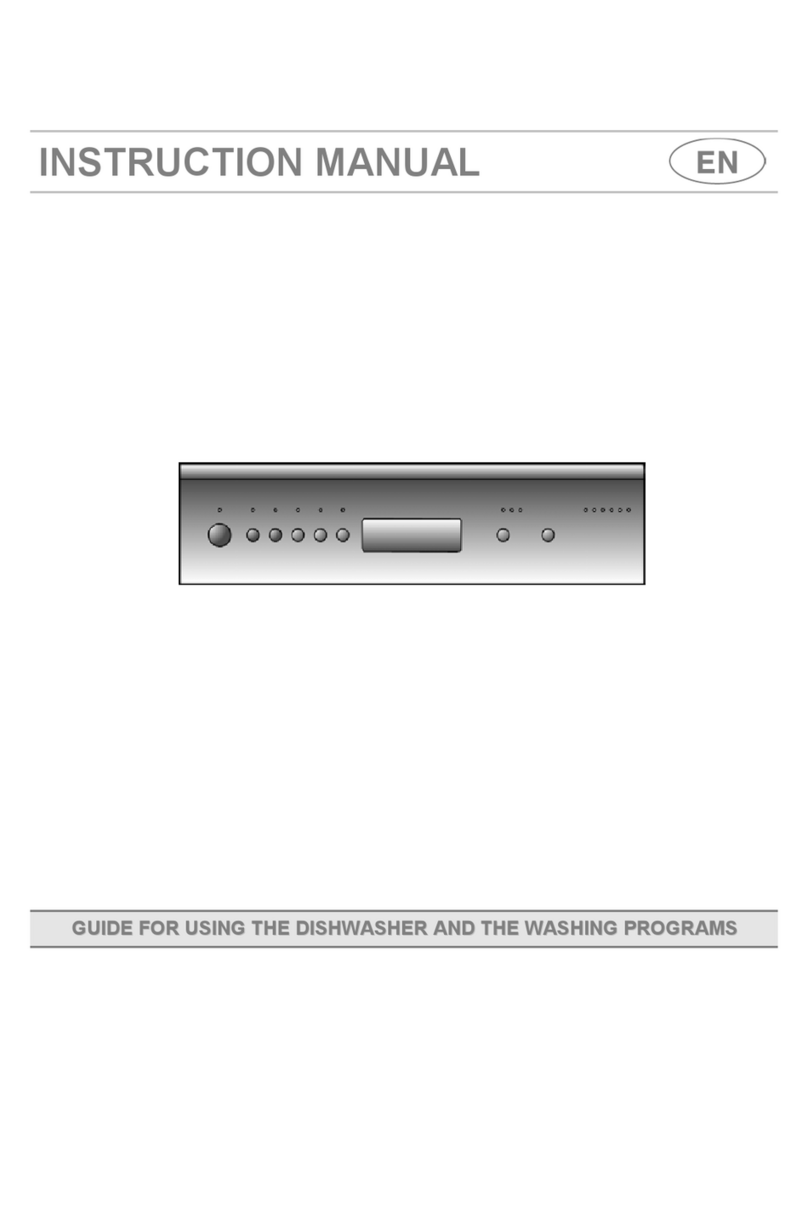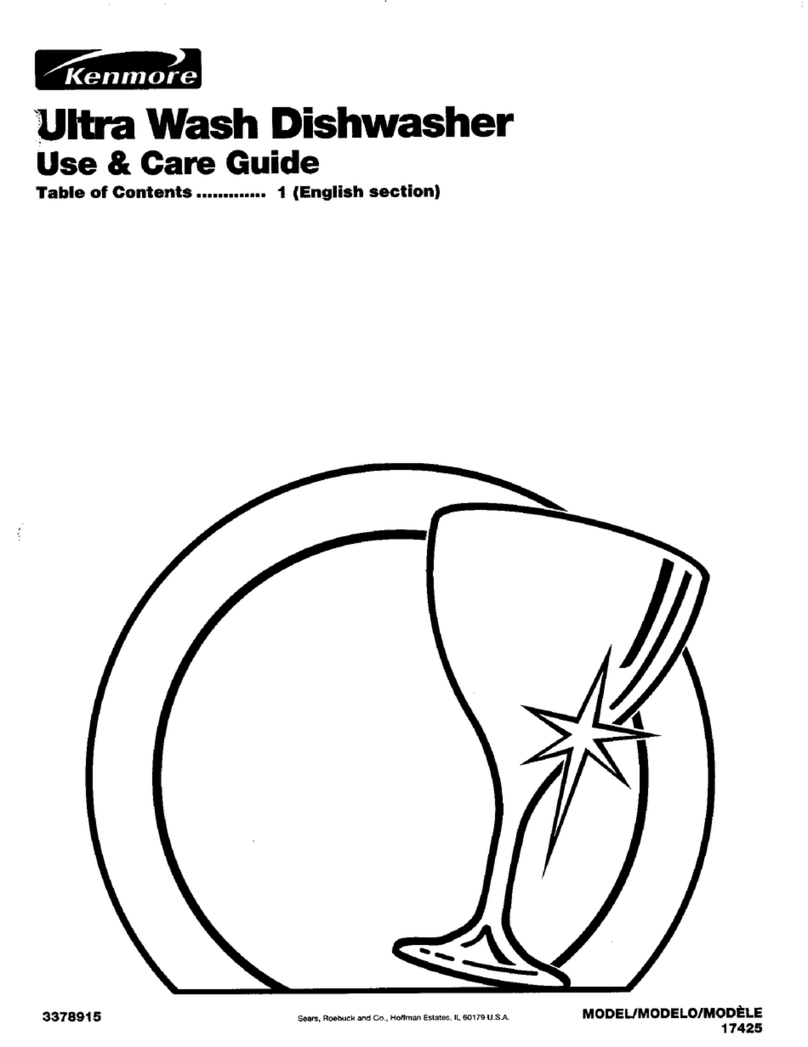Barton 99830 Original instruction manual

SAVE THIS MANUAL: KEEP THIS MANUAL FOR SAFETY WARNINGS, PRECAUTIONS, ASSEMBLY,
OPERATING, INSPECTION, MAINTENANCE AND CLEANING PROCEDURES. WRITE THE PRODUCT’S
SERIAL NUMBER ON THE BACK OF THE MANUAL NEAR THE ASSEMBLY DIAGRAM (OR MONTH AND
YEAR OF PURCHASE IF PRODUCT HAS NO NUMBER).
OWNER’S MANUAL AND SAFETY INSTRUCTIONS
ITEM: 99830 / 99831
FOR QUESTIONS PLEASE CALL OUR CUSTOMER SUPPORT: (909) 628 0880 MON-FRI 9AM TO 3PM PST
COUNTERTOP DISHWASHER

1
GENERAL SAFETY WARNINGS
The warnings, precauons, and instrucons discussed in this instrucon manual cannot cover all
possible condions and situaons that may occur. It must be understood by the operator that common
sense and cauon are factors which cannot be built into this product, but must be supplied by the
operator. Read carefully and understand all instrucons before operang. Failure to follow the safety
rules and other basic safety precauons may result in serious personal injury.
This appliance must be grounded. In the event of a malfuncon or breakdown, grounding will
reduce the risk of electric shock by providing a path of least resistance of electric current. This
appliance is equipped with a grounding conductor and a grounding plug.
SAFETY INFORMATION
The plug must be plugged into an appropriate outlet that is installed and grounded in accordance
with all local codes and ordinances.
SAFETY INFORMATION
Improper connecon of the equipment-grounding conductor can result in a risk of electric shock.
Check with a qualied electrician or service representave if you are in doubt whether the appliance
is properly grounded. Do not modify the plug provided with the appliance; If it is not t for the
outlet. Have a proper outlet installed by a qualied electrician.
DO NOT abuse, sit on, or stand on the door or dish rack of the dishwasher.
DO NOT touch the heang element during or immediately aer use. (This instrucon is only
applicable to machines with a visual heang element.)
DO NOT operate your dishwasher unless all enclosure panels are properly in place. Open the door
very carefully if the dishwasher is operang, there is a risk of water squirng out.
DO NOT place any heavy objects of stand on the door when it is open. The appliance could p
forward.
When loading items to be washed: 1) Locate sharp items so that they are not likely to damage the
door seal; 2) Warning: Knives and other utensils with sharp points must be loaded in the basket
with their points down or placed in a horizontal posion.
When using your dishwasher, you should prevent plasc items from coming into contact with
heang element. (This instrucon is only applicable to machines with a visual heang element.)
Check that the detergent receptacle is empty aer compleon of the wash cycle.
DO NOT wash plasc items unless they are marked dishwasher safe or the equivalent. For plasc
items not so marked, check the manufacturer’s recommendaons.
Use only detergent and rinse addives designed for an automac dishwasher.
NEVER use soap, laundry detergent, or hand washing detergent in your dishwasher. Keep these
products out of the reach of children.

2
SAFETY INFORMATION SAFETY INFORMATION
Keep children away from detergent and rinse aid, keep child away from the open door of the
dishwasher, there could sll be some detergent le inside.
This appliance is not intended for use by persons (including children with reduced physical,
sensory or mental capabilies, or lack of experience and knowledge ,unless they have been given
supervision or instrucon concerning use of the appliance by a person responsible for their safety.
Children should be supervised to ensure that they do not play with the appliance.
Dishwasher detergents are strongly alkaline, they can be extremely dangerous if swallowed. Avoid
contact with skin and eyes and keep children away from the dishwasher when the door is open.
The door should not be le in the open posion since this could present a tripping hazards.
If the supply cord is damaged, it must be replaced by the manufacturer or its service agent or a
similarly qualied person in order to avoid a hazard.
Remove the door to the washing compartment when removing an old dishwasher from service or
discarding it.
Please dispose of packing materials properly.
During installaon, the power supply must not be excessively or dangerously bent or aened.
The door should not be le in the open posion since this could present a tripping hazards. Do not
tamper with controls.
The appliance is to be connected to the water mains using new hose sets and that old hose-sets
should not be reused.
The maximum number of place sengs to be washed is 6.
The maximum permissible inlet water pressure is 1Mpa.
The minimum permissible inlet water pressure is 0.04Mpa.

INSTALLATION INSTALLATION
The posion of the dishwasher should be near the exisng inlet and drain hoses and power cord. One
side of the cabinet sink should be chosen to facilitate the connecon of drain hoses of the dishwasher.
Posion the appliance in the desired locaon. The back should rest against the wall behind it, Posion
the appliance in the desired locaon. The back should rest against the wall behind it, and the sides,
along the adjacent cabinets or wall. The dishwasher is equipped with water supply and drain hoses
that can be posioned to the right or the le to facilitate proper installaon.
POWER CONNECTION:
POWER CONNECTION: look at the rang label to know the rang voltage and connect the
dishwasher to the appropriate power supply. Use the required fuse 10 amp, me delay fuse or circuit
breaker recommended and provide separate circuit serving only this appliance.
Ensure the voltage and frequency of the power being corresponds to those on the rang plate. Only
insert the plug into an electrical socket which is earthed properly. If the electrical socket to which the
appliance must be connected is not appropriate for the plug , replace the socket, rather than using a
adaptors or the like as they could cause overheang and burns.
GROUNDING: This appliance must be earthed. In the event of a malfuncon or breakdown, earthing
will reduce the risk of electric shock by providing a path of least resistance for the electric current. This
appliance is equipped with a cord having an equipment-earthing conductor and an earthing plug. The
plug must be plugged into an appropriate outlet that is installed and earthed in accordance with all
local standards and requirements.
WATER CONNECTION: Your dishwasher
comes equipped with a ‘quick connect’
assembly (includes inlet and drain hose). The
faucet adapter must be installed on the faucet
before you can connect the dishwasher. This
adapter is included inside your dishwasher.
The faucet adapter is compable with faucets
inclusive of either male (outside) or female
(inside) threaded faucet connecons.
3

INSTALLATION INSTALLATION
4
1. Drain port connecon
DRAIN HOSE:
2. Quick connect connecon
3. Inlet port connecon
INLET HOSE:
4. Quick connect connecon
5. Faucet adapter
FAUCET ADAPTER:
6. Faucet washer
QUICK CONNECT:
1. Pressure relief valve
2. Faucet adapter connecon
3. Locking collar
4. Inlet hose connecon
5. Drain hose connecon
NOTE: In order to avoid water staying in the inlet hose, close the faucet aer using it.
Ensure the voltage and frequency of the power being corresponds to those on the rang plate. Only
insert the plug into an electrical socket which is earthed properly.
1. Screw the faucet adapter onto the faucet tap. Check for leaks.
2. Connect the six-sided connecon of the drain hose to the drain port connecon on the back of the
dishwasher cabinet. Do not over-ghten (to avoid damage to threads).
3. Connect the star-shaped connecon of the inlet hose to the inlet port on the back of the dishwasher
cabinet. Do not over-ghten (to avoid damage to threads).
4. Connect the circular connecon of the drain hose onto the longer (boom) male connecon on
the quick connect.
5. Connect the circular connecon of the inlet hose onto the shorter (top) male connecon on the
quick connect.
6. Aach the quick connect onto the faucet adapter, by pulling down the outer locking collar on the
quick connect, while pushing the quick connect upward onto the faucet adapter.
7. When the quick connect snaps onto the faucet adapter, release the locking collar. Verify the
connecon is secure.
8. Slowly open the hot water line and check for any sign of water leaks at all hose connecons. If
leaks are located, immediately close the water supply and repair the hose connecons.
NOTE. Once you open the water supply line, (even if it is closed immediately thereaer), the inlet
hose will be pressurized. To relieve water pressure from inside the inlet hose, (make sure the water
line (faucet) is closed): press and hold the red pressure relief buon on the quick connect unl the
ow of water stops.

CONTROL PANEL / FEATURES
1
2
3
4
5
6
7
POWER: To turn on the
power supply.
POWER LIGHT: Lights up
when power is on.
FAUCET LIGHT: Lights up
when Faucet is on.
RINSE AID: Lights
up when rinse aid is
needed
Program indicator
lights.
PROGRAM SELECTOR: To
select washing cycle.
START/RESET: To start or
pause the washer.
DISHWASHER FEATURES
5

CONTROL PANEL / FEATURES OPERATION
PROGRAM SELECTOR: To
select washing cycle.
START/RESET: To start or
pause the washer.
6
PRIOR TO USING THE DISHWASHER THE FIRST TIME
RINSE AID DISPENSER:
The rinse aid is released during the nal rinse to prevent water from forming lm on your dishes. It
also improves drying by allowing water to sheet o the dishes. Your dishwasher is designed to use
liquid rinse aids. The rinse aid dispenser is located inside the door next to the detergent dispenser.
To ll the dispenser, open the cap and pour the rinse aid into the dispenser unl the level indicator
turns completely black. The volume of the rinse aid container is about 110ml.
RINSE AID FUNCTION:
Rinse aid is automacally added during the last rinse, ensuring thorough rinsing, and spot and streak
free drying.
ATTENTION: Never ll the rinse aid dispenser with any other substances (e.g. Dishwasher
cleaning agent, liquid detergent). This would damage the appliance.
RINSE AID DISPENSER:
If there is no rinse-aid warning light in the control panel, you can judge the amount of rinse-aid by
the color of the opcal level indicator located next to the cap. When the rinse-aid container is full,
the whole indicator will be dark .As the rinse-aid diminishes, the size of the dark dot decreases. You
should never let the rinse aid get below 1 / 4 full.
As the rinse aid diminishes, the size of the black dot on the rinse aid level indicator changes, as
illustrated below.
C. RINSE AID DETECTOR

OPERATION OPERATION
DETERGENTS:
There are 3 sorts of detergents 1. With phosphate and with chlorine 2. With phosphate and without
chlorine 3. Without phosphate and without chloride
Normally new pulverised detergent is without phosphate. The water soener funcon of phosphate
is not given. In this case we recommend to ll salt in the salt container even when the hardness of
water is only 6 dH. If detergents without phosphate were used in case of hard water oen white spots
appear at dishes and glasses. In this case please add more detergent to reach beer results. Detergents
without chlorine do only bleach a lile. Strong and coloured spots will not removed completely. In this
case please choose a programme with higher Temperature.
Based on their chemical composion, dishwasher can be split in two basic types:
CONCENTRATED DETERGENT:
The use of normal washing programmes in conjuncon with concentrated detergents reduces polluon
and is good for your dishes; these wash programmes are specially matched to the dirt-dissolving
properes of the enzymes of the concentrated detergent. For this reason normal wash programmes
in which concentrated detergents are used can achieve the same results that can otherwise only be
achieved using heavy program.
Detergent tablets of dierent brands dissolve at dierent speeds. For this reason some detergent
tablets cannot dissolve and develop their full cleaning power during short programmes. Therefore
please use long programmes when using detergent tablets, to ensure the complete removal of
detergent residuals.
DETERGENT TABLETS:
NOTE: Detergent tablets are only for the models with 3 in 1 funcon or 3 in 1 program.
DETERGENT DISPENSER:
The dispenser must be relled before the start of each wash cycle following the instrucons provided
in the Wash Cycle Table . Your dishwasher uses less detergent and rinse aid then convenonal
dishwasher. Generally, only one tablespoon of detergent is needed for a normal wash load. Also,
more heavily soiled items need more detergent. Always add the detergent just before starng the
dishwasher, otherwise it could get damp and will not dissolve properly.
7

OPERATION OPERATION
8
AMOUNT OF DETERGENT TO USE:
LOADING DISHWASHER BASKETS
NOT SUITABLE LIMITED SUITABILITY
BEFORE AND AFTER LOADING DISHWASHER BASKETS
Scrape o any large amounts of leover food. Soen remnants of burnt food in pans It is not necessary to rinse the
dishes under running water. Place objects in the dishwasher in following way: 1. Items such as cups, glasses, pots/pans,
etc. are face down. 2. Curved items, or those with recesses, should be loaded at a slant so that water can run o. 3. All
utensils are stacked securely and can not p over. 4. All utensils are placed in the way that the spray arms can rotated
freely during washing.

OPERATION
Posion the dishes and cookware so that they will not get moved by the spray of water.
LOADING THE BASKET:
CUTLERY BASKET:
WASH CYCLE TABLE:
9

OPERATION OPERATION
10
LOADING THE BASKET:
STARTING A WASH CYCLE:
1. Draw out the basket(see the secon entled Loading the Dishwasher );
2. Pour in the detergent (see the secon entled Detergent and Rinse Aid );
3. Insert the plug into the socket. The power supply is 120V/60 Hz;
4. Make sure that the water supply is turned on to full pressure;
5. Close the door and press the power buon to turn on the power supply.
6. Press the Program buon to select the wash program you need. NORMAL > LIGHT > MINIPARTY >
RINSE > SPEED > HEAVY
7. Then press the START / RESET buon and the dishwasher will begin to start.
CHANGING THE PROGRAM:
You can modify the washing program if the dishwasher runs for a short me. Otherwise, the detergent
may have already been released, and the appliance may have already drained the wash water. If this is
the case, the detergent dispenser must be relled (see the secon tled “ Loading Detergent “
To change the washing program, more than three seconds the machine will be in stand by state, then
you can change the program to the desired cycle seng. See Starng Wash Cycle secon. The lights
show the state of the dishwasher:
A) All phase lights o: Stand By
B) Display not blinking: Paused
C) Display is blinking: Running
NOTE: If you open the door when washing, the machine will pause. When closing the door, press the
START buon to start the wash cycle back up.
END OF WASH CYCLE:
When the working cycle has nished, the buzzer will sound for 8 seconds, then stop. Turn o the
appliance using the Power buon, shut o the water supply and open the door of the dishwasher.
Wait a few minutes before unloading the dishwasher to avoid handling the dishes and utensils while
they are sll hot and more suscepble to breakage. They will also dry beer. Since the appliance is
standing by, it will power o automacally aer 30 minutes without any operaon
TURNING OFF THE DISHWASHER: All phase lights are o indicang the program has ended.
1. Turn o the dishwasher by pressing the POWER buon.
2. Make sure to turn o the water tap.
NOTE: Take care when opening the dishwasher and handling dishes, they will be hot. Aer a wash has
ended, it is recommended to leave the door open for 30 minutes before unloading.
STARTING THE DISHWASHER: Check to make sure the following steps are followed
1. The dishwasher is level and xed properly.
2. The inlet valve is open
3. There are no leakages at the connecons of the conducts
4. Wires are ghtly connected
5. Power is switched on
6. Inlet and drain hoses are knoed

MAINTENANCE
The lter prevents larger remnants of food from geng inside the pump.
END OF WASH CYCLE:
The lter eciently removes food parcles from the wash water, allowing it to be recirculated during
the cycle. For best performance and results, the lter assembly must be regularly. This reason, it is
a good idea to remove the larger food parcles trapping in the lter aer each wash cycle by rinsing
the lter and cup under running water. To remove the lter assembly, pull on the cup handle in the
upward direcon.
11

MAINTENANCE MAINTENANCE
12
CLEANING THE FILTER:
To clean the coarse lter and the ne lter, use a cleaning brush. Reassemble the lter parts as shown
in the gures in the last page and reinsert the enre assembly in the dishwasher, posioning in its seat
and pressing downward.
CLEANING THE DISHWASHER:
To clean the edge around the door, you should use only a so
warm, damp cloth. To avoid penetraon of water into the door
lock and electrical components, do not use a spray cleaner of
any kind.
The spray arms can be easily removed for periodic cleaning of the nozzles, to prevent possible clogging.
Wash them under running water and carefully replace them in their seats, checking that their rotary
movement is in no way impeded. Grasp the middle of the spray arm, pull it upwards to remove it.
Wash the arms under a jet of running water and return them carefully to their seat. Aer reassembly,
check that the spray arms turn freely. Otherwise, check that they have been installed correctly.
CLEANING THE SPRAY ARMS:
Aer every wash, turn o the water supply and
leave the door slightly open so that moisture
and odors are not trapped inside.
Before cleaning or performing Maintenance,
always remove the plug from the socket.
To clean the exterior and rubber parts of the
dishwasher, do not use solvents or abrasive
cleaning products. Only use a cloth with warm
soapy water. To remove spots or stains from the
surface of the interior, use a cloth dampened
with water with a lile vinegar, or a cleaning
product made specically for dishwashers.
It is recommend that you run a wash cycle with
the dishwasher empty and then remove the
plug from the socket, turn o the water supply
and leave the door of the appliance slightly
open. This will help the door seals to last longer
and prevent odours from forming within the
appliance.
If the appliance must be moved, try to
keep it in the vercal posion. If absolutely
necessary, it can be posioned on its back.
One of the factors that cause odors to form
in the dishwasher is food that remains
trapped in the seals. Periodic cleaning
with a damp sponge will prevent this from
occurring.

TROUBLESHOOTING TECHNICAL DATA
Before calling for service, review the charts below for common troubleshoong techniques.
ERROR CODES:
13

TROUBLESHOOTING TECHNICAL DATA
14

WARRANTY
15
THE MANUFACTURER AND/OR DISTRIBUTOR HAS PROVIDED THE PARTS LIST AND ASSEMBLY
DIAGRAM IN THIS MANUAL AS A REFERENCE TOOL ONLY. NEITHER THE MANUFACTURER OR
DISTRIBUTOR MAKES ANY REPRESENTATION OR WARRANTY OF ANY KIND TO THE BUYER THAT
HE OR SHE IS QUALIFIED TO MAKE ANY REPAIRS TO THE PRODUCT, OR THAT HE OR SHE IS
QUALIFIED TO REPLACE ANY PARTS OF THE PRODUCT. IN FACT, THE MANUFACTURER AND/OR
DISTRIBUTOR EXPRESSLY STATES THAT ALL REPAIRS AND PARTS REPLACEMENTS SHOULD BE
UNDERTAKEN BY CERTIFIED AND LICENSED TECHNICIANS, AND NOT BY THE BUYER. THE BUYER
ASSUMES ALL RISK AND LIABILITY ARISING OUT OF HIS OR HER REPAIRS TO THE ORIGINAL
PRODUCT OR REPLACEMENT PARTS THERETO, OR ARISING OUT OF HIS OR HER INSTALLATION
OF REPLACEMENT PARTS THERETO.
PLEASE READ THE FOLLOWING CAREFULLY
Record Product’s Serial Number Here:
Note: If product has no serial number, record month and year of purchase instead.
Note: Some parts are listed and shown for illustration purposes only and are not available individually
as replacement parts.
PRODUCT MADE IN CHINA
This manual suits for next models
1
Table of contents
Popular Dishwasher manuals by other brands

Insinger
Insinger Commander 18-6 Technical manual

KitchenAid
KitchenAid KUDD03STBL - Single Drawer Dishwasher installation instructions
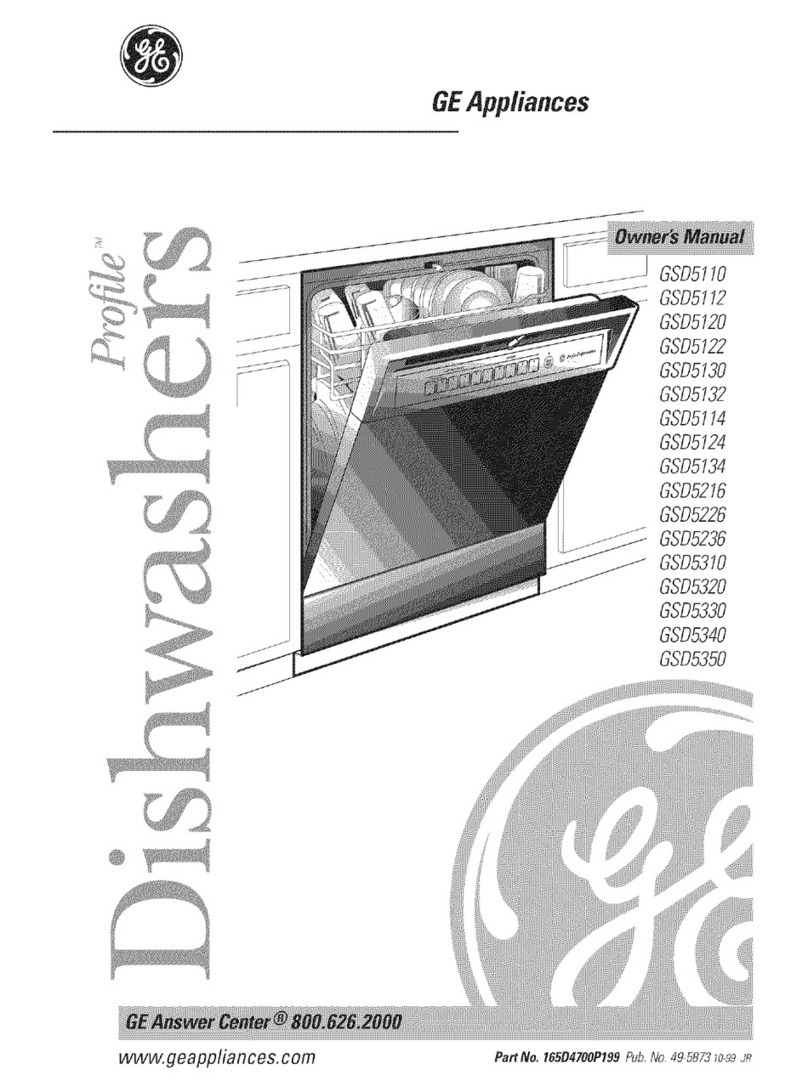
GE
GE Triton GSD5110 owner's manual
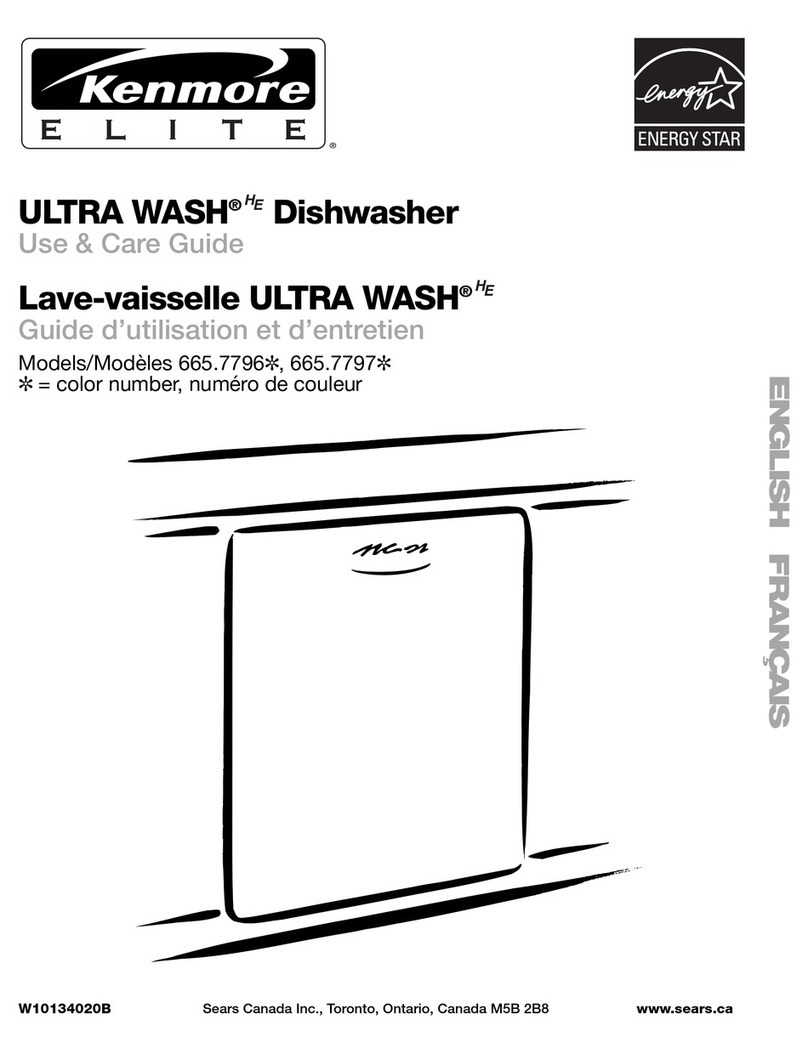
Kenmore
Kenmore 665.7796 series Use & care guide
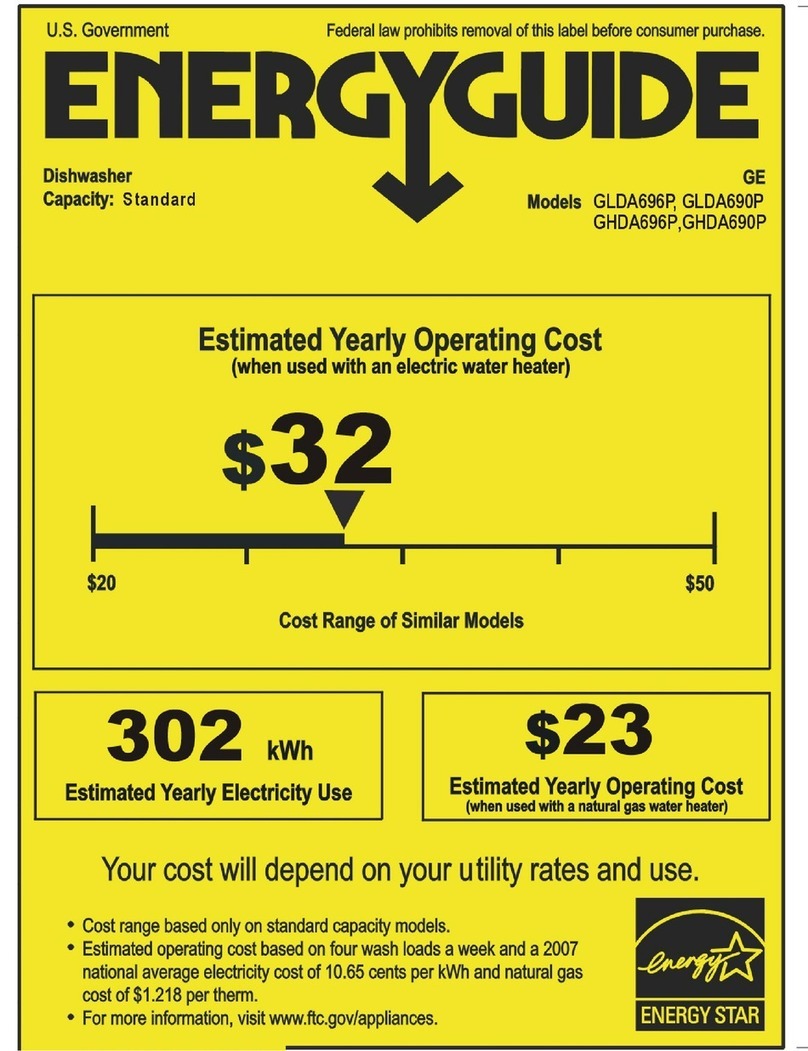
GE
GE GLDA690PWW - 24-in Tall Tub Dishwasher Energy guide
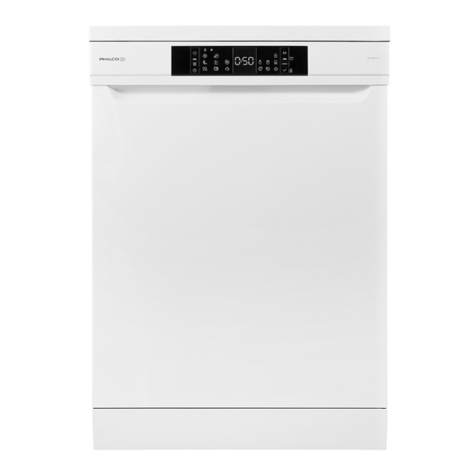
Philco
Philco PDI 1568 DLT owner's manual
